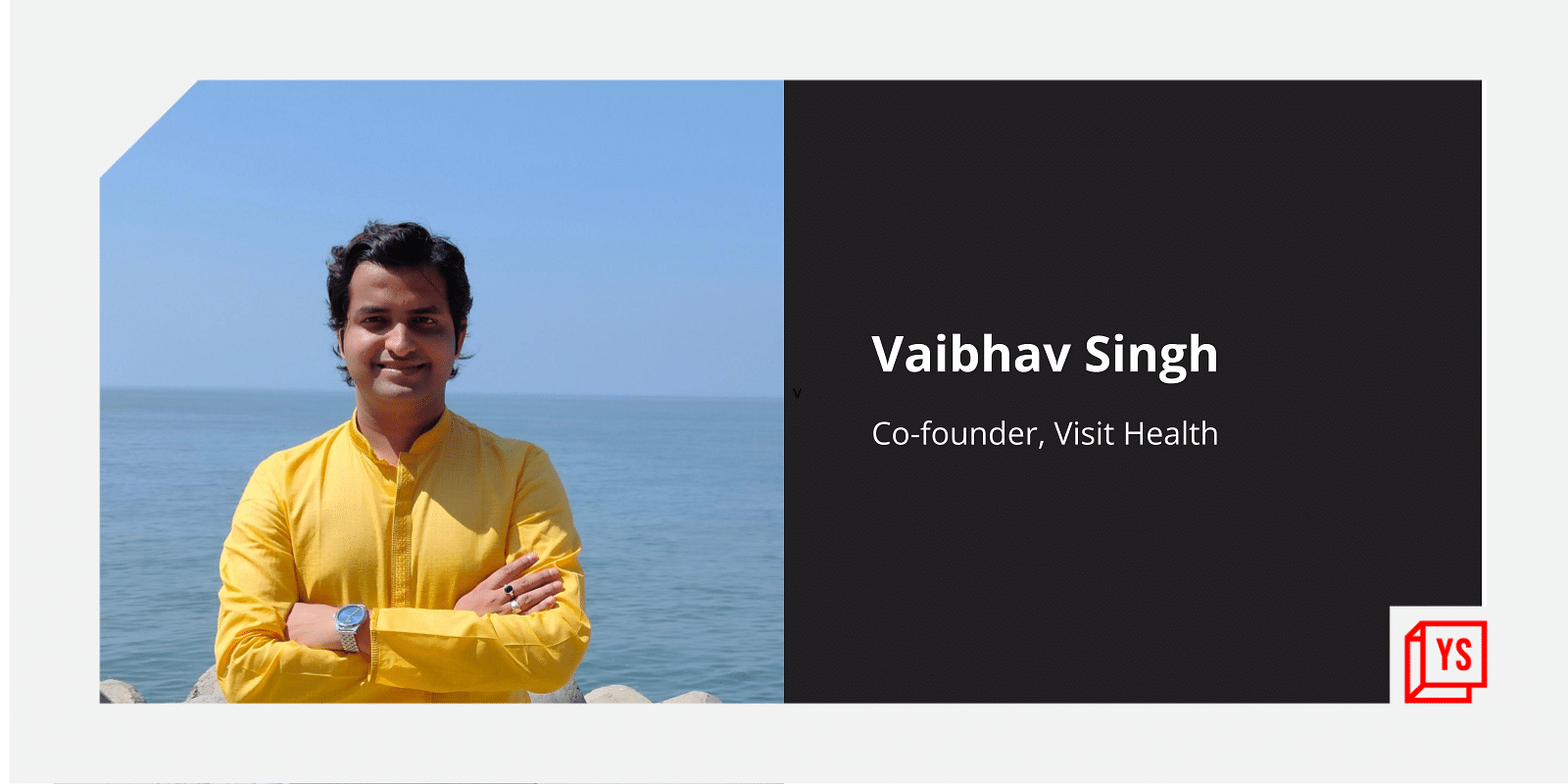While studying engineering around 2011 at BITS Pilani, which is located in a small city in North-eastern part of Rajasthan, Vaibhav Singh lived through the problem of limited healthcare access in rural towns.
People from his college had to travel about 200 kms away to either Delhi or Jaipur for the slightest inconvenience.
“There were a lot of panic situations within the college, and we realised that there’s hardly anything we could do when it comes to healthcare,” he says.
Vaibhav and his friends decided to start working on a database, which would list students’ parents who were doctors. The students could contact a toll-free number, which would connect them to the doctors in the database, who could help them out by understanding their symptoms.
This formed the basis of Visit Health, a healthcare startup based in Delhi.
Founded by BITS Pilani graduates Vaibhav Singh, Shashvat Tripathi, Chetan Anand, and Anurag Prasad in 2015, the startup allows corporate employees to manage their healthcare needs using their smartphones.
Through the platform, enterprises can enhance healthcare experience and optimise medical costs for all their employees.
Problem statement and evolution
Over time, the co-founders noticed the problem of healthcare access even in urban areas, where despite better access, the private healthcare system wasn’t quick and efficient.
“For the smallest things, you would probably end up spending half your day in booking an appointment, travelling to the place for a maximum of five to six-minute appointment,” Vaibhav says. “For that, you spend a good amount of five to six hours of your day.”
For Vaibhav, it seemed like healthcare hadn’t changed much in the past 20 years in India. “The interesting part was, all our other life avenues had changed drastically in the last 10 years, but healthcare was still pretty much the same,” he says.
In 2015, while most of his batchmates were preparing for placements, he decided to pursue the idea of digital healthcare, turning down an offer from pharma company Biocon, where he had interned previously.
He researched the space to find out the issues in the healthcare industry – the way the infrastructure was developed or used, the consumption of the services, and the mentality of the people. “Everything just seemed very broken,” he says.
The four co-founders decided to work on the idea in a small two-bedroom apartment in Noida. About 14 people – them and some interns – lived in the same place working on the product.
“It was very difficult. If we were not determined to the extent we were, it was difficult seeing your peers doing that. But good for us that we took the plunge,” Vaibhav says.
What it does
Visit Health is a fully-integrated, 360-degree primary healthcare platform. The startup helps corporations design primary care, which includes medical services before hospitalisation, as well as wellness solutions for employees and their dependents.
Its offerings include doctor on call/chat, in-clinic specialist consultations, prescribed diagnostic tests, diet & wellness coaching, and mental health assistance services. Visit’s end consumers can connect to medical specialists on call and get prescriptions through its telehealth and telemedicine speciality.
Visit Health’s Out Patient Department (OPD) has a network of more than 28,000 doctors from hospitals and clinics with whom consumers can book appointments.
“We have brought them into our network and we provide cashless consultations to our users who have subscribed for OPD benefits,” Vaibhav says.
Visit offerings also include sleep and activity tracking among other things. It uses Artificial Intelligence to check symptoms and manage daily activity to keep chronic diseases in check.
The market and funding
Visit Health decided to approach its consumers through companies, unlike the standalone consumer apps in the space.
For Visit, it is the employers who are choosing to work with it and pay for its services and the beneficiaries are the employees in companies and their families.
“For the majority of the population, everything is out of pocket expense,” says Vaibhav.
The subscription ranges from Rs 100 to Rs 7,000 per family per year, depending on the program a corporate selects.
He explains, “We don’t have an average existing coverage from an insurer or anyone which can provide these things. So, the problem always existed and still exists for everyone. We wanted to solve the problem of the entire chain of wellness and primary care.”
In its early days, Visit worked with the corporates – a strategy that worked out well. Now, most companies in this space are taking the B2B route.
Corporates already had a system in place where they provided secondary insurance cover to their employees. Also, a lot of organisations had started offering mental-health wellness programmes to its employees.
Visit wanted to leverage these levers, “bring everything under one umbrella and streamline the entire process,” says Vaibhav.
Employers buy a subscription plan for their employees, who get the benefits based on the plan chosen and do not have to pay for the services they use. They can pay over and above this to avail more services.
In October 2021, Visit Health raised $7.5 million from Docprime Technologies, a fully-owned subsidiary of PB Fintech — the parent company of PolicyBazaar and Paisabazaar.
It had previously raised $1.4 million as part of its seed round, which had investors such as Snapdeal founders Kunal Bahl and Rohit Bansal. It also raised funds from Twitter co-founder Biz Stone.
Its revenue grew 10 times in the last two years, and the company claims to be profitable for the last 18 months.
Partnerships
On the supply side, the company has built a network of doctors who either provide teleconsultations or allow users to book offline appointments. Its network of doctors for in-clinic extends to over 40 cities.
Visit has also partnered with major diagnostic labs such as Apollo and SRL, through which users can book appointments and can get their samples collected from home, depending on the tests.
Vaibhav says the company has around 1,500 diagnostic centres covered, roughly covering more than 3,800 pin codes.
The startup has also partnered with pharmacies such as Apollo to supply medicines based on prescriptions. It has partnered with dieticians, nutritionists, and psychologists to support multiple features and cater to digital healthcare requirements of consumers in the post-pandemic world.
“You need to bring as many touchpoints as possible to be relevant to the masses,” says Vaibhav.
Recently, the startup has roped in insurance brokers who are keen on building holistic programmes rather than just providing for secondary healthcare.
At present, the company has nine insurers and three brokers on the platform.
Growth and plans ahead
Visit competes with different players in different services such as MFine, HealthifyMe, and Medibuddy.
“In a corporate, we have groups starting from 20 to 55. The kind of services Visit provides, it’s relevant to anyone and everyone. So, everyone has something to get and utilise from Visit. Hence our engagement is very high,” says Vaibhav.
Visit’s in-app currency has also contributed to the engagement, which users can use to get exclusive deals. “We started rewarding people for keeping good health,” says Vaibhav.
Working with customers like IBM, Axis Bank, Swiggy, Wipro, and The Times Group, the company is serving more than 12 lakhs lives covered employees at present.
The employee engagement and customisations at an organisational as well as individual employee level allows it to have an average sign-up rate of up to 70 percent with 40-45 percent monthly active users.
Visit has grown to a 109-member team from a 28-member team before the pandemic.
In the next few months, the startup is working on building its tech integrations with all its stakeholders. It is also focusing on growing its mental health offerings, gamification, and OPD network.










